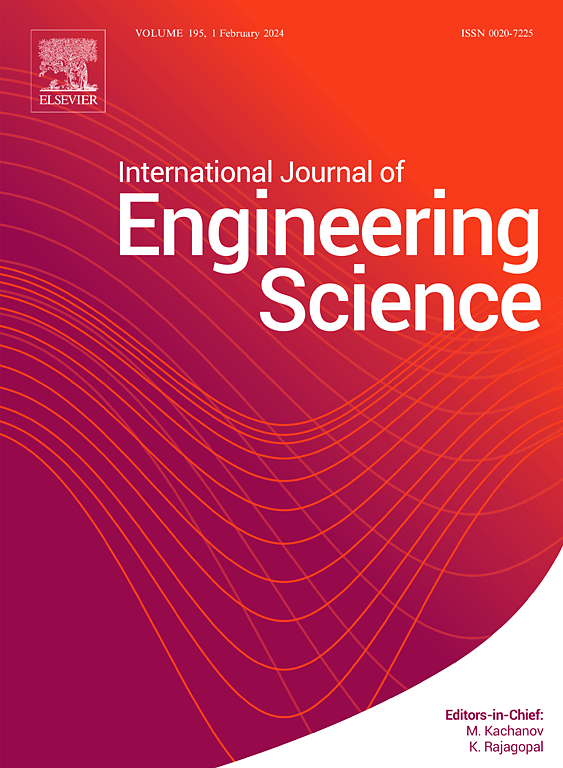弱奇异曲面上Rivlin-Ericksen张量的Hadamard相容条件
IF 5.7
1区 工程技术
Q1 ENGINEERING, MULTIDISCIPLINARY
International Journal of Engineering Science
Pub Date : 2025-09-19
DOI:10.1016/j.ijengsci.2025.104382
引用次数: 0
摘要
我们在Hadamard和Thomas的意义上考虑弱奇异曲面。这种奇异曲面上速度梯度的跳跃条件已经建立,并经常用于局部变形的分岔分析。本文首次给出了Rivlin-Ericksen张量的跳跃条件。对于物质运动,导出了传播奇异表面和静止奇异表面的跳跃条件。我们展示了应变加速度不连续的几何结构和不可压缩性所带来的额外限制。事实证明,对于固定(即物质)不连续,所有高阶Rivlin-Ericksen张量的跳跃非线性地依赖于速度梯度的跳跃。这使得在某些非牛顿本构模型中描述不连续的简单设置成为可能。本文章由计算机程序翻译,如有差异,请以英文原文为准。
Hadamard compatibility conditions for Rivlin–Ericksen tensors on weak singular surfaces
We consider weak singular surfaces in the sense of Hadamard and Thomas. The jump condition for the velocity gradient across such singular surfaces is well established and often used in the bifurcation analysis of localized deformation. In this paper, we present the jump conditions for the Rivlin–Ericksen tensors for the first time. With regards to a material motion, the jump conditions are derived for both propagating and standing singular surfaces. We showcase the geometric structure of strain acceleration discontinuities and the additional restrictions posed by incompressibility. It turns out, for standing (i.e. material) discontinuities the jumps of all higher-order Rivlin–Ericksen tensors depend nonlinearly on the jump of the velocity gradient. This enables a simple setting for the description of discontinuities in certain non-Newtonian constitutive models.
求助全文
通过发布文献求助,成功后即可免费获取论文全文。
去求助
来源期刊

International Journal of Engineering Science
工程技术-工程:综合
CiteScore
11.80
自引率
16.70%
发文量
86
审稿时长
45 days
期刊介绍:
The International Journal of Engineering Science is not limited to a specific aspect of science and engineering but is instead devoted to a wide range of subfields in the engineering sciences. While it encourages a broad spectrum of contribution in the engineering sciences, its core interest lies in issues concerning material modeling and response. Articles of interdisciplinary nature are particularly welcome.
The primary goal of the new editors is to maintain high quality of publications. There will be a commitment to expediting the time taken for the publication of the papers. The articles that are sent for reviews will have names of the authors deleted with a view towards enhancing the objectivity and fairness of the review process.
Articles that are devoted to the purely mathematical aspects without a discussion of the physical implications of the results or the consideration of specific examples are discouraged. Articles concerning material science should not be limited merely to a description and recording of observations but should contain theoretical or quantitative discussion of the results.
 求助内容:
求助内容: 应助结果提醒方式:
应助结果提醒方式:


